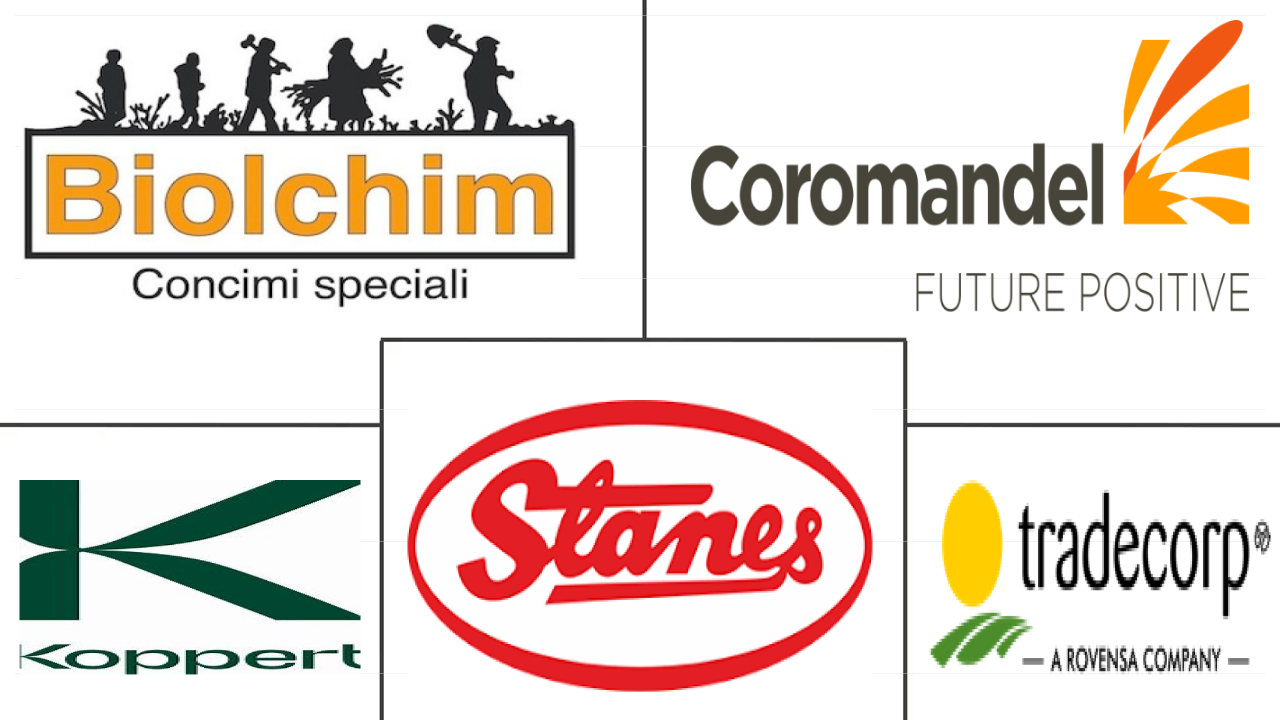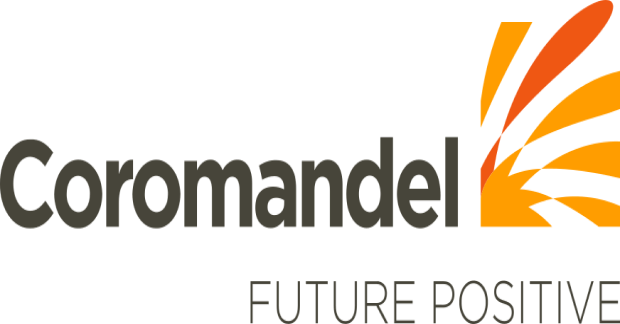Market Size of africa biostimulants Industry
| Icons | Lable | Value |
|---|---|---|
|
|
Study Period | 2017 - 2029 |
|
|
Market Size (2024) | USD 127.76 Million |
|
|
Market Size (2029) | USD 197.53 Million |
|
|
Largest Share by Form | Amino Acids |
|
|
CAGR (2024 - 2029) | 9.11 % |
|
|
Largest Share by Country | Nigeria |
Major Players |
||

|
||
|
*Disclaimer: Major Players sorted in no particular order |
Africa Biostimulants Market Analysis
The Africa Biostimulants Market size is estimated at 127.76 million USD in 2024, and is expected to reach 197.53 million USD by 2029, growing at a CAGR of 9.11% during the forecast period (2024-2029).
127.76 Million
Market Size in 2024 (USD)
197.53 Million
Market Size in 2029 (USD)
5.32 %
CAGR (2017-2023)
9.11 %
CAGR (2024-2029)
Largest by Form
31.97 %
value share, Amino Acids, 2023
The dominance of aminoacid-based biostimulants is mainly due to their ability to improve seed germination and seedling growth, improve the crop tolerance to various stresses.
Fastest by Form
10.23 %
Projected CAGR, Humic Acid, 2024-2029
The humic acid based biostimulant increase nutrient uptake, and the overall reduction in chemical inputs, and can be easily applied by fertigation or soil application methods
Largest by Crop Type
75.85 %
value share, Row Crops, 2023
Biostimulants are becoming a more popular alternative to chemical fertilizers for crop management in cereals such as rice, maize, wheat, and barley in the African region.
Largest by Country
7.21 %
value share, Nigeria, 2023
The consumption of seaweed extract-based biostimulants is dominant the market, this is due to the easy availability due to seaweed farming along the coastline of the country.
Leading Market Player
5.33 %
market share, Coromandel International Ltd, 2022

The company offers various biostimulant products specific to agriculture, landscape, nursery, turf, and lawn & garden that Helps in strengthening plant defense mechanism.
- Amino acid-based biostimulants dominate the African market, valued at USD 35.3 million in 2022. Amino acid-based biostimulants are widely used because of their ability to enhance seed germination and seedling growth, improve crop resilience to various biotic and abiotic stresses, boost nutrient uptake and utilization, especially with regard to nitrogen and phosphorus, and amplify the efficiency of other agricultural inputs such as pesticides and fertilizers.
- The benefits of humic acid-based biostimulants, such as increased stress tolerance, increased nutrient uptake, and an overall reduction in chemical inputs, as well as their ease of application via fertigation or soil application methods, may drive the market, with the market value expected to grow by about 78.5% to USD 49.6 million by the end of the forecast period.
- Humic acid-based biostimulants, which are a type of organic soil amendment derived from humic substances found in soil, peat, coal, and other fossil deposits, are known to enhance soil health and plant growth. They are rich in humic acids. These biostimulants account for the second-largest market share, representing 23.4% of the African biostimulant market by value in 2022.
- Seaweed extract-based biostimulants can potentially improve their market share in the African region due to their abundant availability in many coastal areas and their ability to decrease the need for chemical fertilizers in agriculture. These factors may drive the demand for seaweed-based biostimulants during the forecast period. Seaweed extract-based biostimulants accounted for about USD 23.1 million in 2022.
- Humic and fulvic acid-based biostimulants are anticipated to grow faster than other biostimulants during the forecast period.
- Africa is known for its diverse agricultural systems, with a wide range of crops grown across the region. Agriculture plays a vital role in the African economy, and organic farming gained traction, with approximately 120 thousand hectares of organic crop area in 2021. Cereal crops, such as maize, wheat, and corn, are among the most widely grown crops in the region.
- One area of growth in African agriculture is the biostimulants market, which saw a significant increase in value, rising by approximately 18.7% from 2017 to 2021. This growth is expected to continue, with the market value projected to increase by 67.8%.
- The majority of the African biostimulants market is dominated by the Rest of African region, accounting for about 81.1% of the market value in 2022. Tunisia is the top organic producer in terms of area, and Ethiopia has the highest number of organic producers, with approximately 220,000 in 2020. However, the lack of legislation for organic farming in most African countries has hampered the establishment of a well-established biostimulant market in some areas.
- Seaweed-based biostimulants make up 43.8% of the market value, valued at about USD 3.4 million in 2022. The use of seaweed extract-based biostimulants is prevalent in Nigeria.
- The demand for biostimulants in Africa is expected to rise in the coming years, driven by increasing consumer interest in organic products, both domestically and internationally. Farmers are becoming more informed about the drawbacks of heavy reliance on chemical inputs and the economic benefits of using biostimulants. With these factors in play, the biostimulants market in Africa is poised for significant growth, providing opportunities for both farmers and businesses in the region.
Africa Biostimulants Industry Segmentation
Amino Acids, Fulvic Acid, Humic Acid, Protein Hydrolysates, Seaweed Extracts are covered as segments by Form. Cash Crops, Horticultural Crops, Row Crops are covered as segments by Crop Type. Egypt, Nigeria, South Africa are covered as segments by Country.
- Amino acid-based biostimulants dominate the African market, valued at USD 35.3 million in 2022. Amino acid-based biostimulants are widely used because of their ability to enhance seed germination and seedling growth, improve crop resilience to various biotic and abiotic stresses, boost nutrient uptake and utilization, especially with regard to nitrogen and phosphorus, and amplify the efficiency of other agricultural inputs such as pesticides and fertilizers.
- The benefits of humic acid-based biostimulants, such as increased stress tolerance, increased nutrient uptake, and an overall reduction in chemical inputs, as well as their ease of application via fertigation or soil application methods, may drive the market, with the market value expected to grow by about 78.5% to USD 49.6 million by the end of the forecast period.
- Humic acid-based biostimulants, which are a type of organic soil amendment derived from humic substances found in soil, peat, coal, and other fossil deposits, are known to enhance soil health and plant growth. They are rich in humic acids. These biostimulants account for the second-largest market share, representing 23.4% of the African biostimulant market by value in 2022.
- Seaweed extract-based biostimulants can potentially improve their market share in the African region due to their abundant availability in many coastal areas and their ability to decrease the need for chemical fertilizers in agriculture. These factors may drive the demand for seaweed-based biostimulants during the forecast period. Seaweed extract-based biostimulants accounted for about USD 23.1 million in 2022.
- Humic and fulvic acid-based biostimulants are anticipated to grow faster than other biostimulants during the forecast period.
| Form | |
| Amino Acids | |
| Fulvic Acid | |
| Humic Acid | |
| Protein Hydrolysates | |
| Seaweed Extracts | |
| Other Biostimulants |
| Crop Type | |
| Cash Crops | |
| Horticultural Crops | |
| Row Crops |
| Country | |
| Egypt | |
| Nigeria | |
| South Africa | |
| Rest of Africa |
Africa Biostimulants Market Size Summary
The Africa Biostimulants Market is experiencing significant growth, driven by the increasing adoption of biostimulants in agriculture across the continent. This market is characterized by a diverse range of products, including amino acid-based, humic acid-based, and seaweed extract-based biostimulants, each offering unique benefits such as enhanced seed germination, improved crop resilience, and increased nutrient uptake. The demand for these products is fueled by the need for sustainable agricultural practices that reduce reliance on chemical inputs and improve soil health. The market is further supported by the growing interest in organic farming and the increasing consumer demand for organic products, both locally and internationally. Despite the challenges posed by the lack of legislation and infrastructure in some regions, the market is poised for substantial growth, providing opportunities for farmers and businesses alike.
The market landscape is fragmented, with key players like Biolchim SPA, Coromandel International Ltd, and Koppert Biological Systems Inc. leading the charge. These companies are actively innovating and expanding their product offerings to meet the evolving needs of the agricultural sector. The African biostimulants market is dominated by the Rest of Africa region, with countries like Tunisia and Ethiopia playing significant roles in organic production. As the market continues to expand, it is expected to contribute to the region's economic development by enhancing agricultural productivity and supporting the transition towards more sustainable farming practices. The increasing per capita income and health awareness among consumers are also driving the demand for organic foods and beverages, further bolstering the market's growth prospects.
Africa Biostimulants Market Size - Table of Contents
-
1. MARKET SEGMENTATION (includes market size in Value in USD and Volume, Forecasts up to 2029 and analysis of growth prospects)
-
1.1 Form
-
1.1.1 Amino Acids
-
1.1.2 Fulvic Acid
-
1.1.3 Humic Acid
-
1.1.4 Protein Hydrolysates
-
1.1.5 Seaweed Extracts
-
1.1.6 Other Biostimulants
-
-
1.2 Crop Type
-
1.2.1 Cash Crops
-
1.2.2 Horticultural Crops
-
1.2.3 Row Crops
-
-
1.3 Country
-
1.3.1 Egypt
-
1.3.2 Nigeria
-
1.3.3 South Africa
-
1.3.4 Rest of Africa
-
-
Africa Biostimulants Market Size FAQs
How big is the Africa Biostimulants Market?
The Africa Biostimulants Market size is expected to reach USD 127.76 million in 2024 and grow at a CAGR of 9.11% to reach USD 197.53 million by 2029.
What is the current Africa Biostimulants Market size?
In 2024, the Africa Biostimulants Market size is expected to reach USD 127.76 million.

